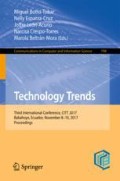Abstract
This paper is a guide to risk analysis of implanted electronic devices in humans. The development of science and technology made global changes about dangers that threaten the security of humanity, however, in recent years there had arisen a new field of analysis for these implanted devices, contributing important elements. In this research, the authors tried to collect all the technological aspects concerning for some electronic devices that can be implanted in the body that can be hacked, to identify the possible computer attacks that they could suffer. The author’s research different threats to which these electronic devices are exposed and how to find the way to reduce such threats and vulnerabilities. As well as to differentiate the types of attacks, the way that they operate and how they affect its operational function processes denoting an operational impact of these, such as an analysis of the prevention, detection, and mitigation of the main vulnerabilities.
Access this chapter
Tax calculation will be finalised at checkout
Purchases are for personal use only
References
Castillo, A.: Riesgos tecnológicos y seguridad aparente: revisión y análisis para definición y reconocimiento (2013). http://www.laccei.org/LACCEI2013-Cancun/RefereedPapers/RP284.pdf
López, A., Macaya, C.: Libro de la salud cardiovascular del hospital clínico San Carlos y la Fundación BBVA. BBVA (2015)
Estacio, J.: Los riesgos tecnológicos en el DMQ: la paradoja del desarrollo urbano y el síndrome de nuevos escenarios de riesgos y desastres (2015). http://www.flacsoandes.edu.ec/biblio/shared/biblio_view.php?bibid=111097&tab=opac
García, C.: Seguridad en Smartphone Análisis de riesgos de vulnerabilidad y auditorias dispositivos (2017). http://openaccess.uoc.edu/webapps/o2/handle/10609/60705
Gasson, M.: Dispositivos electrónicos en el cuerpo humano. Cuerpo Humano Electrónico, pp. 13–17 (2015)
Gil, E.: Ciencias para llevar. Obtenido de Nano-básculas para pesar virus y bacterias en la detección de enfermedades, 10 June 2017. https://blogs.20minutos.es/ciencia-para-llevar-csic/
Mejía, C., Ramírez, M.: Vulnerabilidad, tipos de ataques y formas de mitigarlos en las capas del modelo OSI en las redes de datos de las organizaciones. PEREIRA: Universidad Tecnológica de Pereira - facultad de ingenierías eléctrica, electrónica, física y ciencias de la computación (2015)
Páu, M.: Medio humano, medio máquina. La vanguardia, pp. 20–28 (2015)
Perazo, C.: Chips bajo la piel. La Nación, pp. 20–25 (2014)
Ruiz, A.: Foros de la virgen. Obtenido de Militares están desarrollando microchips para implantaren el cerebro, 6 September 2014. http://forosdelavirgen.org/81431/en-que-estamos-respecto-a-la-implantacion-de-microchips-2014-09-06/
Sánchez, A.: Piel electrónica y super sensible (2015). http://cuerpohumanoelectronico.blogspot.com/2015/12/piel-electronica-y-super-sensible_29.html
Vásquez, T.: Medicina y actividad creadora. Obtenido de Estamos abocados a convertirnos en cíborgs? 26 June 2017. http://www.expansion.com/economia-digital/innovacion/2017/07/26/5977b44622601db35c8b4645.html
Vélez, A.: Tecnología avanzada ciencias médicas (2014). http://www.eltiempo.com/archivo/documento/CMS-14674255
Zapata, L.: Evaluación y mitigación de ataques reales a redes IP utilizando tecnologías de virtualización de libre distribución. In: INGENIUS, pp. 16–19 (2012)
Bazaka, K., Jacob, M.V.: Implantable devices: issues and challenges. Electronics 2(1), 1–34 (2013)
Petersen, B.T.: Implanted electronic devices at endoscopy: advice in a gray area. Gastrointest. Endosc. 65, 569–570 (2007)
Petersen, B.T., Hussain, N., Marine, J.E., et al.: Endoscopy in patients with implanted electronic devices. Gastrointest. Endosc. 65, 561–568 (2007)
Logan, J., Boushahri, A.: Cardiovascular implantable electronic devices. Hosp. Med. Clin. 6(1), 1–15 (2017)
Hiestand, B.: Cardiac implantable electronic devices. In: Peacock, W. (ed.) Short Stay Management of Acute Heart Failure. Contemporary Cardiology, pp. 285–294. Humana Press, Cham (2017). https://doi.org/10.1007/978-3-319-44006-4_22
Kallet, R.H.: How to write the methods section of a research paper. Respir. Care 49, 1229–1232 (2004)
Halamka, J., et al.: The security implications of verichip cloning. J. Am. Med. Inform. Assoc. 13(6), 601–607 (2006)
Bono, S., Green, M., Stubblefield, A., Juels, A., Rubin, A., Szydlo, M.: Security analysis of a cryptographically-enabled RFID device. In: 14th USENIX Security Symposium, pp. 1–16, Baltimore, Maryland, USA, July–August 2005
Hopkins, T.J.: FDA approves implantable chip to access medical records. BMJ Br. Med. J. 329(7474), 1064 (2004)
Pycroft, L., Boccard, S., Owen, S.L.F., Stein, J., FitzGerald, J., Green, A.L., Pereira, E.: Brainjacking: implant security issues in invasive neuromodulation. World Neurosurg. 92, 454–462 (2016). https://doi.org/10.1016/j.wneu.2016.05.010
Radcliffe, J.: Hacking medical devices for fun and insulin: breaking the human SCADA system. n.d. Black Hat, 20 April 2014. http://media.blackhat.com/bh-us-11/Radcliffe/BH_US_11_Radcliffe_Hacking_Medical_Devices_WP.pdf
Cruz, T., Queiroz, R., Simoes, P., Monteiro, E.: Security implications of SCADA ICS virtualization: survey and future trends (2016). https://doi.org/10.13140/RG.2.1.1064.2167
Rios, B., Butts, J.: Security evaluation of the implantable cardiac device ecosystem architecture and implementation interdependencies (2017)
Zhang, M., Raghunathan, A., Jha, N.K.: MedMon: securing medical devices through wireless monitoring and anomaly detection. IEEE Trans. Biomed. Circ. Syst. 7(6), 871–881 (2013). https://doi.org/10.1109/TBCAS.2013.2245664
Shirkhani, S.: What is the future of startups? (2012). http://shahramshirkhani.com/
Cellan-Jones, R.: BBC News - First human ‘infected with computer virus’ (2010). http://davidhuerta.typepad.com/blog/2010/05/bbc-news---first-human-infected-with-computer-virus.html
Zorz, Z.: Brainjacking: Hacking brain implants (2016). https://www.helpnetsecurity.com/2016/08/26/hacking-brain-implants/
NDSS Pump Consumables, Insulin pumps (2017). https://www.diabetesaustralia.com.au/insulin-pumps
Diabetes: How Do Insulin Pumps Work? (2015). http://www.diabetes.org/living-with-diabetes/treatment-and-care/medication/insulin/how-do-insulin-pumps-work.html
Aleppo, G.: Insulin Pump Overview (2016). https://www.endocrineweb.com/guides/insulin/insulin-pump-overview
Orangel y Sulma (2012). www.slideshare.net/Orangelescritura
PCRisk, Heart Stopping Vulnerabilities (2017). https://www.pcrisk.com/internet-threat-news/11295-heart-stopping-vulnerabilities
Wadhwa, T.: Yes, You Can Hack a Pacemaker (And Other Medical Devices Too) (2012). https://www.forbes.com/forbes/welcome/, https://www.forbes.com/sites/singularity/2012/12/06/yes-you-can-hack-a-pacemaker-and-other-medical-devices-too
Author information
Authors and Affiliations
Corresponding author
Editor information
Editors and Affiliations
Rights and permissions
Copyright information
© 2018 Springer International Publishing AG
About this paper
Cite this paper
Ferruzola-Gómez, E., Duchimaza-Supliguicha, J., Bermeo-Almeida, O., Pérez-Espinoza, C., Samaniego-Cobo, T., Bazán-Vera, W. (2018). Risk Analysis of Implanted Electronic Devices in Human Beings. In: Botto-Tobar, M., Esparza-Cruz, N., León-Acurio, J., Crespo-Torres, N., Beltrán-Mora, M. (eds) Technology Trends. CITT 2017. Communications in Computer and Information Science, vol 798. Springer, Cham. https://doi.org/10.1007/978-3-319-72727-1_7
Download citation
DOI: https://doi.org/10.1007/978-3-319-72727-1_7
Published:
Publisher Name: Springer, Cham
Print ISBN: 978-3-319-72726-4
Online ISBN: 978-3-319-72727-1
eBook Packages: Computer ScienceComputer Science (R0)

